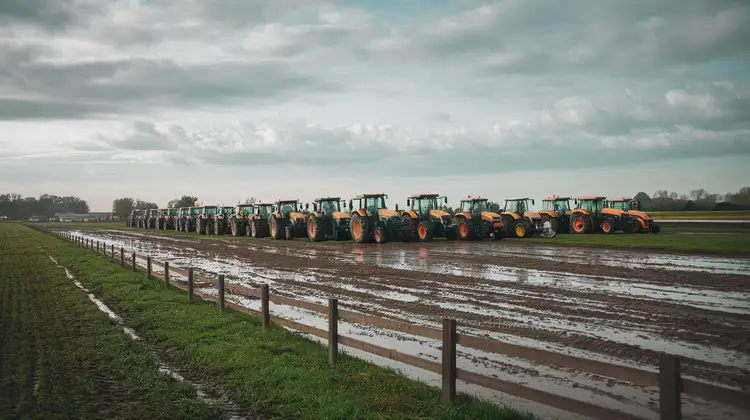Best Agricultural Loan – Grow Your Farm with Flexible Financing!
Published: 14 Dec 2024
An agricultural loan is a financial instrument, which assists the farmers in funding the purchases of inputs, investments in the farmland and other equipments required to promote the farming business. Whether it is to acquire new and efficient farming equipment, to expand the farming land or even upgrade existing farming equipment, what you need is an agricultural loan which provides that much needed freedom in farming to enable you to realize the vision for your farm.
What is an Agricultural Loan?
An agricultural loan is defined as that form of credit that is specifically provided to farmers and ranchers for financing agricultural activities. These are loans meant for financing of different farming purposes which may include acquisition of land for farming, land reclamation, acquisition of farming implements or rearing of farming livestock.
| Feature | Description | Benefits |
|---|---|---|
| Flexible Terms | Customizable loan terms to match your financial situation and business needs. | Helps ensure your loan is manageable based on farm operations and revenue cycle. |
| Low Interest Rates | Competitive interest rates tailored for agricultural borrowers. | Save money on interest payments and reinvest in your farming operation. |
| Easy Application Process | A straightforward application process with minimal paperwork and fast approvals. | Quick access to the capital you need for land or equipment purchases. |
| Land and Equipment Financing | Loan programs available for both land acquisition and agricultural equipment financing. | Get the capital needed for expanding your farm and purchasing necessary equipment. |
Traditionally, they are completely different from other loans because of their structure. They tend to have:
Compared to personal and business loans the interest rate is generally low.
Flexible repayment schedules
Hearing and implementing longer periods for loan repayment so that farmers will not have a lot of pressure when it comes to meeting their cash obligations

Agricultural loans are used to finance new technologies, working capital for peaks seasons in the farming calendar and increasing the production efficiency of the farms. Concerning the actual facilities, the characteristics of agricultural credits are focused to address the necessities of the farmers and face the risk that agribusiness entities present in managing vast operations.
Types of Agricultural Loans
There are many kinds of agricultural loans, aimed at specific goals. They consist of farm loans, USDA loans, equipment loans and livestock loan. Knowledge of these two types of loans will enable you make the right decision with regard to which loan type to go for.
2.1 Farm Loans
Farm loans are flexible, open account, non-specific as to deeds and cereals loans for agricultural operations. Co-op approvals can be for a range of purposes such as purchasing the land, improvements on the land, regular business expenses, working capital and other necessary farming requirements. They often give long durations of a tenure of repayment and very low interest charges; hence, they suit farmers who are in need of capital to expand their farms or acquire land.
- Farm loans are often offered by:
- Banks
- Farm Credit Institutions
- Cooperatives
- Repayment period depends on type of the loan but short term and long term loans are possible available to farmers.
2.2 USDA Loans
The United States Department of Agriculture (USDA) provides many different agricultural loans which are aimed at helping a farmer who does not otherwise have an option of getting a more traditional loan. These loans are useful for the farmers who have started farming or do not have good credit or who do not get loans from other sources.
Key features of USDA loans include:
- Flexible interest rates what can hardly be regarded as high and elongated terms of repayment.
- However, there circumstances under which the customer does not have to make any down payment.
- Reasonable and self-serving criteria for credit scoring like low Dok requirement and a shorter minimum credit record for farmers who may not be inansas debts anymore
Some examples of USDA loan programs include:
- Operating Loans for purchase of land and decommissioning of facility.
- Working capital or other expense to acquire varying operating loans.
- Credit facilities for new farmers within the market System for initial entry into farming business
- USDA financing has constantly been selected by the farmers when obtaining credit since it is fairly easy to acquire especially where the farmer is a small-scale farmer or has a low credit rating.

2.3 Equipment Loans
The loans can only be used to buy or refurbish farming instruments like tractors, harvesters, irrigation instruments, equipment as well as others. These loans are collateralized by the financed equipment, in a sense that the lender takes a recourse against the equipment in case the borrower fails to pay back the loans.
Farmers can use equipment loans to
- The decision can be to buy the machinery new or used
- Financing equipments and its repair or improvement
- See the farming business grow to larger production
Equipment loans are usually more flexible as an option, depending on the type of equipment needed you may be able to get the loan from a Farm credit institution or an equipment financing company. Interest rates on these loans range with the cost, age of the equipment and credit score of the borrowers.
2.4 Livestock Loans
Stock credit offers farmers with credit facilities in form of cash, crops or goods, machinery and other things needed in farming, including the purchase of livestock. These credit facilities are used mainly in-financing the purchase of livestock such as cattle, poultry, pigs or any other animal. Some types of livestock loans, especially those provided to finance the stocking of livestock, are provided on short terms and repaid upon sale of the livestock and realization of income.
Farmers can use livestock loans to
- Buy breeding stock
- Breed animals for their meat or for milking purposes
- Breed improvement and productivity per head
- The stock production loans usually demand the preparation of a proper business plan and evidence of income or sale from prior stock farming. These loans may also specify that the livestock being borrowed may be security depending on the kind of lender an individual is borrowing from.
Advantages of an Agricultural Loan
Agricultural loans are very useful and here are some advantages of taking a loan in agriculture. These loans allow maximum flexibility of funds in financing needs and can be used for short and long term requirements of the farmers. Here are the main benefits of agricultural loans:
3.1 Capital for Growth
The first and simplest advantage of taking an agricultural loan is that it grants the farmer an opportunity to obtain financing for the expansion of his farm or for improvements therein. That means, with the adequate financing, you can purchase the plot, get the new equipment or upgrade the buildings of the farming company. This allows one to escalate their operations and hence the capacity to produce in times of bound funds.

3.2 Lower Interest Rates
Agricultural loans, unlike other types of loans, are usually a little cheaper in terms of interest rates. As the loan is associated with agricultural production, the interest rates can be more attractive on this loan product. Further, most of the government guaranteed loans for instance the USDA loans come along with interest rates that are lower than the market rates.
3.3 Flexible Repayment Terms
Flexible repayment is something that has made agricultural loans quite popular because depending on the type of loan one can take years to clear their debts. Some of the residual repayment terms that borrowers are allowed to select depends with the income cycles of the farmers. For example, farmers can choose to have the payment options on an annual or seasonal production basis or on the cash flows.
3.4 Tax Deductions
Sometimes the interest on the agricultural loans that are issued can be claimed as a deduction on taxes. This way, you’re able to minimize your liability when it comes to taxes and enhance your cash in flow. It is important to seek professional help from a tax consultant in order to establish if one will be eligible to any loans have provisions for deductions.
3.5 Improved Productivity
When farmers receive the money from an agricultural loan, they are able to put the money into a use like machinery, better land, all or technology that would enhance farm production. For instance, buying sophisticated farming machinery, can ease operations, cut on costs of paying employees and above all boost production.
Helpful Information that you need to understand so that you can be granted a loan for agricultural business.
To secure an agricultural loan you need to be financially and eligibly qualified as per the standards set by the lending institutions. While the requirements may vary depending on the type of loan, the lender and your specific circumstances, here are some of the factors typically considered:
4.1 Credit Score
Credit score is among the important considerations for eligibility to an agricultural loan. Banks and other credit institutions tend to attract clients with good or, even better, high credit scores, as there’s a higher chance of recovering the lent sum. Still, it is the university to note that there are certain loans that are backed up by the government for they have a more relaxed credit standard like USDA loans.
4.2 Farm Business Experience
They also consider your experience in the management of farm business. It is also likely that farmers who demonstrate profitability and performance will receive loans. However, new farmers may still apply for USDA loans or apply for other loans given to farmer start-ups in the agriculture trade.
4.3 Collateral
Since a lot of agricultural loans are backed up by the land, equipments or stock being financed, the lender may call for collateral to minimize the risk of giving out the loan. The value of the collateral can determine the size of the loan and that of the interest rate on the loan.
4.4 Cash Flow and Financial Stability
Lenders will be interested in how cash flows in your farm and the general financial health of your venture. Remember before you are given the loan you will have to prove that you have the capacity to repay the loan by showing your income and any other resource you have. This may include requesting too, for tax returns, financial statements and other accounting documents.
4.5 Loan Purpose
Borrowers may also be asked the reason for borrowing the money. Regardless of whether you are buying the land, changing its quality or investing in more effective equipment, any financer would expect a clear business plan and loan purpose.
| Benefit | Description | Impact |
|---|---|---|
| Increased Productivity | Loans provide the financial resources to invest in new technologies and equipment. | Increases farm efficiency, enabling better crop yields and livestock management. |
| Cash Flow Management | Flexible repayment terms allow you to manage your cash flow effectively throughout the year. | Helps manage seasonal income fluctuations and plan for future growth. |
| Land Expansion | Funding to purchase more agricultural land or expand current farming operations. | Provides greater capacity for growing crops, raising livestock or other farming ventures. |
| Financial Security | Loan options with low interest and long repayment periods provide long-term financial security. | Reduces financial stress and creates stability in the farming business for generations. |
What You Should Know About Agricultural Loan
Here are considerations to follow when applying for an agricultural loan Just like any formal process of credit formation and procurement when you are well equipped, the application for an agricultural loan can be very easy. Follow these steps to improve your chances of securing a loan:
Step 1: Research Loan Options
First of all you need to find out all the various forms of agricultural loans that can be offered to you. For this reason, you can decide to take Farm Credit loan, USDA loan or equipment loan, depending on the type of loan you want. Although they share many similarities, they have different terms and conditions of operation the farmer should consider to enroll in the type that suits his or her farming activities.
Step 2: Prepare Financial Documents
- Gather all necessary documentation, such as:
- The concrete documents include tax returns of the last two or three years.
- income statement, expenditure account or statement of profit and loss account, statement of assets and liabilities or balance sheet.
Credit history
A business plan (for new farmers)
Lenders need to understand how your financial status looks like hence the need to present well analyzed documents.
Step 3: Submit Your Application
Send your application to the lender. In the current world, most firms engaged in lending activities have adopted online applications to ease the process. It’s crucially important to complete all the necessary forms completely and truthfully, if necessary providing all needed documents.
Step 4: Wait for Approval
When financing your business, personal and business finances, credit score and the intended use of the loan will be scrutinized by the lender after you complete the application process. Again, the time it takes to receive a decision as to whether or not the loan is approved varies from one lender to the other and may take 2-6 weeks.
Step 5: Accept the Loan
When you get a nod, read the terms of the loan, properly. Be very careful with such rates, terms of repayment and charges pertaining to the loan. Should you be satisfied, you execute the loan agreement and the monies will be dispersed.

Conclusion
Farming loans are among the most important facilitators for the improvement and expansion of farming businesses. Thus, it is possible to state that to implement its activities, the credit union offers a diversity of loan issues, such as Farm Credit loans or USDA loans, as well as equipment loans, so the farmers have an opportunity to obtain adequate financial resources to increase the share of their businesses. These lessons include the two major types of loans, the qualification process and how to apply for a loan for your farm’s future.
FAQs
What is an agricultural loan?
An agricultural loan can generally be defined as a loan that has been especially developed for farmers in order to meet the different requirements of the farming industry including; expenses to be incurred in acquiring land, machines, animals or even to upgrade on farm facilities.
Do I have to have a good credit to get an agricultural loan?
This is feasible especially for USDA loans or a Farm Credit loans since the qualification requirements involving credit check for the intending farmers tend to be much relaxed.
What loan is available for agricultural financing and how much can I be offered as a loan?
Loan amount vary with the type of loan, your financial capability and the intended use of the loan. Loans can therefore be as little as 3 thousand or as much as millions of dollars.
How does the time taken to get approved an agricultural loan vary?
The approval time stands between 2 and 6 weeks, provided that you apply for the loan type offered by the specific lender.

- Be Respectful
- Stay Relevant
- Stay Positive
- True Feedback
- Encourage Discussion
- Avoid Spamming
- No Fake News
- Don't Copy-Paste
- No Personal Attacks

- Be Respectful
- Stay Relevant
- Stay Positive
- True Feedback
- Encourage Discussion
- Avoid Spamming
- No Fake News
- Don't Copy-Paste
- No Personal Attacks





